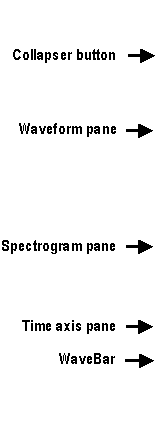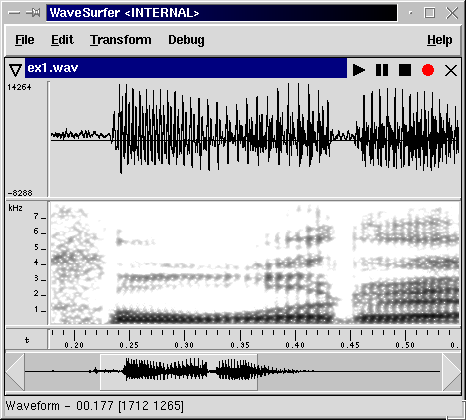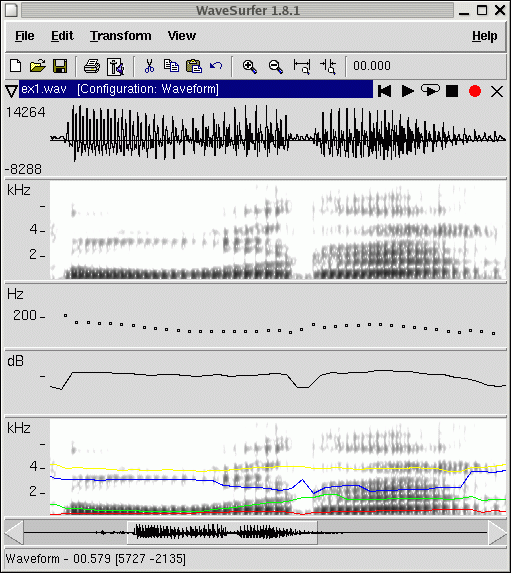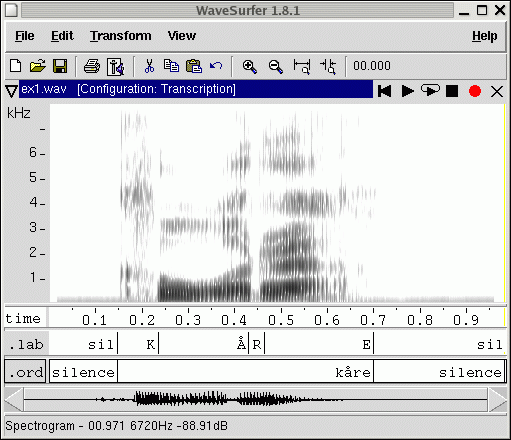
 |
| ©2005 Kåre Sjölander and Jonas Beskow |
| User Manual |
|---|


Right-clicking on the different parts of the interface brings up a popup menu with choices that are applicable to that part. (Use Ctrl-Mousebutton on the Macintosh.)
The WaveBar is used to navigate in a sound file. The left mouse button is used for scrolling and the middle mouse button (or shift-left button) is used for zooming. If your mouse is equipped with a scrollwheel, you can use this for scrolling and zooming in the sound under the mouse pointer: Spinning the wheel up & down will scroll, pressing Ctrl and spinning the wheel will zoom.
Use the tape recorder controls to play and record audio. If a current selection exists only that segment is played. You can use the space bar to toggle between play and pause. Right-clicking on the play button brings up a popup menu with different play options.
For more sophisticated tasks, a single waveform view of the whole sound might not be sufficient. You might want to zoom in to look at small portions, you might want other representations such as spectrograms or pitch-curves, or maybe you have a multi-channel sound and want to look at each channel individually. To allow for this and many other tasks, WaveSurfer gives you the possibility of adding panes. A pane is a window stacked on top of the WaveBar that can contain for example a waveform, a spectrogram, a pitch-curve, a time axis or a transcription or something else. (In fact, through the use of WaveSurfer's plug-in architechture, a pane can contain pretty much anything you can think of!)To add a new pane, you right-click on the WaveBar or any existing pane where you want to insert the new pane, select Create Pane, and choose what type of pane you want.
Unlike the WaveBar, a pane will not necessarily display the whole sound. Rather it will display a portion of the sound that is specified in the WaveBar. Think of the WaveBar as an overview and the pane as a variable magnifying glass.
A sound can contain any number of panes (as long as they fit on the screen) They will be stacked on top of each other and always be aligned in time.
Once the pane is created it can be resized vertically by dragging the handle below the pane. (Some panes such as transcription and time axis can not be resized) You can also control many properties of the pane by selecting Properties | Pane from the popup menu (right-click).
It is possible to modify various properties of a pane by selecting Popup | Properties. Depending on the specific type of pane, there will be different tabs in the dialog. For example, it will allow you to modify the color scale and analysis parameters of a spectrogram.
For a certain task, you might want a specific set-up of panes, with specific properties. WaveSurfer comes with a set of ready-to-use pane configurations, for transcription, speech analysis, etc. You can easily define your own configurations. Once you have created a set of panes and set their properties as needed, you simply choose Save Configuration from the popup menu. Once the configration is saved, it will appear as a choice when you select File | New. It is possible to change the pane configuration used for a sound by selecting Popup | Apply Configuration. A configuration does not only specify what panes should be visible, but also their sizes and everything else that can be specified in the Popup | Properties dialog. The configuration files reside in ~/.wavesurfer/1.8/configurations/ and under some circumstances it might be useful to edit them by hand. For example, the configuration n-waveforms has been created in this way. Examine that configuration in a text editor to get an idea of how this can be done.
All panes share the current selection. Selections are made in the standard way, press-drag-release mouse button 1. The selection can be adjusted by dragging the bars marking the endpoints or by pressing shift and clicking mouse button 1. Clicking the play button causes the marked region to be played. The endpoints of the current selection can be adjusted to the nearest zero crossing using Edit | Zero Cross Adjust.
The Edit menu contains basic editing functions such as cut, copy, and paste. The Transform menu contains transformation functions for conversions, amplification, normalization etc. On the View menu zoom functions can be found. The Master Sound option makes it possible for one window to control the zoom-level and scroll position of other windows.
You can convert properties such as frequency, number of channels, and sample encoding format using the dialog in Popup | Properties | Sound.
WaveSurfer creates postscript files for printing. See the FAQ for information on how to print these on Windows.
The preferences dialog (File | Preferences...) is used to specify global properties of WaveSurfer. These include
- commands used to print and preview
- key-bindings
- interpretation of raw sound data from file name extension
- method of sound storage management
- maximum recording time
- automatic scroll during playback
- temporary work directory
- maximum zoom-in level
The mixer dialog (File | Mixer...) is used to control volume and select output/input jacks.

Many
properties of these panes can be adjusted using Popup | Properties. In
addition, a spectrum window can be opened using Popup | Spectrum Section.
Special control windows are available for Waveforms and Spectrograms, which
allows the user to make quick modifications. A special enlarged waveform window,
which is centered around the cursor, can be opened using Popup | Waveform
Blow-up. This is useful for detailed inspection and adjustment.

Use the
properties-dialog to specify which label file that should be displayed in a
transcription pane. It is usually practical to create a special configuration
for a certain combination of sound and transcription files, specifying file
properties such as filename extension, label format, and character encoding.
There are many options to control appearance and editing functionality.
Depending on the transcription file format additional options might be
available. Unicode characters are supported if using the source version of
WaveSurfer, in order to keep the binary versions small. See the Tcl language
documentation for a list of available character encodings. The transcription
plug-in is used in combination with format handler plug-ins which handle the
conversion between file formats and the internal format used by the
transcription plug-in. The standard popup menu has additional entries for
transcription panes. Popup | Load Transcription and Popup | Save
Transcription are used to load and save transcription files. Label editing
is straightforward, simply click where you want to insert a label and type it
in. The label fields are user-configurable and used to insert a label directly
at the cursor position. You can either drag time boundaries using the mouse or
use Ctrl-r/Ctrl-l to right/left justify boundaries with the cursor. It is
possible to specify where WaveSurfer should look for transcription files using
Properties | Trans1 | Label file path entry, or Properties | HTK |
Master Label File. The latter is used in the case of HTK transcriptions
contained in an HTK MLF-file with immediate definitions. HTK label files need to
have both start and end times specified. Choosing File | Save will save a
modified transcription in addition to any sound changes.
-playstart playing as soon as the sound is loaded.-config configurationuse the configuration and do not query the user for one. WaveSurfer uses the first matching configuration it can find. If no one matches, a wavebar will be displayed.-filelist fileload the file list contained in file (text file with one file name per line). This list will be displayed in the Chooser dialog for quick access in large file sets.-master filenamewhen loading several sound files at once, specify which sound's wavebar will control the rest. For example, wavesurfer.tcl -config Waveform -master ex1.wav ex1.wav ex2.wav, will make the first sound's wavebar control the second one as well. Same function can be had by choosing View | Master Sound | ex1.wav.-tfa filenamesearch the specified WaveSurfer Transcription File Archive. Several options can be specified and they will apply to the corresponding transcription pane counting from the top.-mlf filenamesearch the specified HTK Master Label File (only for HTK format transcription panes). Several options can be specified and they will apply to the corresponding transcription pane counting from the top.-filelist fileload the file list contained in file (text file with one file name per line). This list will be displayed in the Chooser dialog for quick access in large file sets.-debug levelgenerate a debug trace which is useful when trying to track down bugs. Use with a value of 6 for the level parameter in order to generate the trace file wsurf.log.